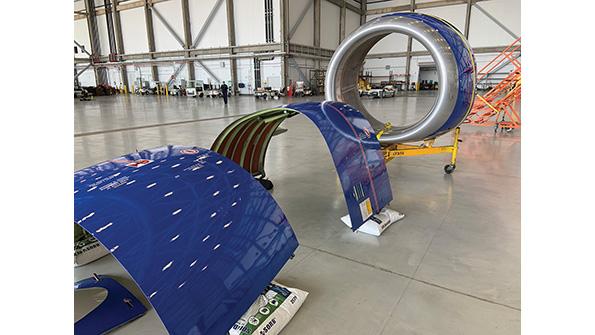
Signs of buoyancy in the MRO market abound. Many big-name companies reported solid 2021 fourth-quarter figures—including GE Aviation’s services business, which was up 37% year-over-year, anchored by the “strength in external shop visits (up 40%),” says Jeffries analyst Sheila Kahyaoglu. She notes that Raytheon’s Pratt & Whitney and Collins Aerospace’s aftermarket businesses were up 28% and 47%, respectively, in quarter four. For this year, “Our expectations are for 21% expansion in aftermarket revenues across the broader [Raytheon] group,” she says.
On the airframe side, “we’re now experiencing an increasing demand for routine maintenance and MRO services associated with recommissioning stored aircraft,” says Charlie McDonald, AerSale’s chief technical officer and president of airframe MRO. “This in turn is driving a dramatic increase in demand for aircraft reconfigurations, interior modifications, cargo conversions and exterior painting, amid what is already a tight labor market.”
While it’s encouraging to hear that demand for various types of airframe MRO work is increasing, the tight labor market and supply chain woes will continue to create bottlenecks if companies don’t adequately plan ahead.
SR Technics is seeing that lead times for new OEM parts have increased significantly, especially for engines such as the Pratt & Whitney PW4000, says Caroline Vandedrinck, senior vice president for business development.
For used serviceable material (USM), especially for types in high demand, “the industry needs to focus more on a proactive basis than a reactive basis,” says Hunter Edens, Aero Capital Solution’s senior director for asset management, who spoke at Aviation Week’s Aero-Engines Americas on Jan. 27.
For engines, he suggests acquiring and tearing down engines now for shop visits up to 18 months out due to the time required to tear them down, repair the parts and stock them. He predicts a continued bottleneck of available USM until the industry shifts to proactive mode from reactive.
With engine shop visits building back up after two years of deferrals or “hospital,” or on-wing, services, expect higher demand for expensive parts such as high-pressure compressors. As OEMs ramp up airframe and engine production, the pressure for suppliers to support new-production parts plus those for existing platforms will strain the supply chain. This will require careful planning by all. Accept this as the new normal.
Speaking of today’s dynamic market and its realities, “I’m not saying that everything [in the market] is rosy by any means. But I also think that it’s really good to not compare ourselves to 2019. Let’s move on,” Marjan Riggi, managing director of aviation for Kroll Bond Rating Agency, said at Aviation Week’s Engine, Leasing, Trading & Finance Americas on Jan. 26.
I agree. Move on, stay healthy and carpe diem.





